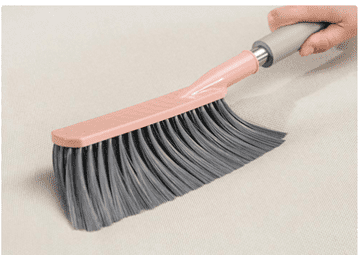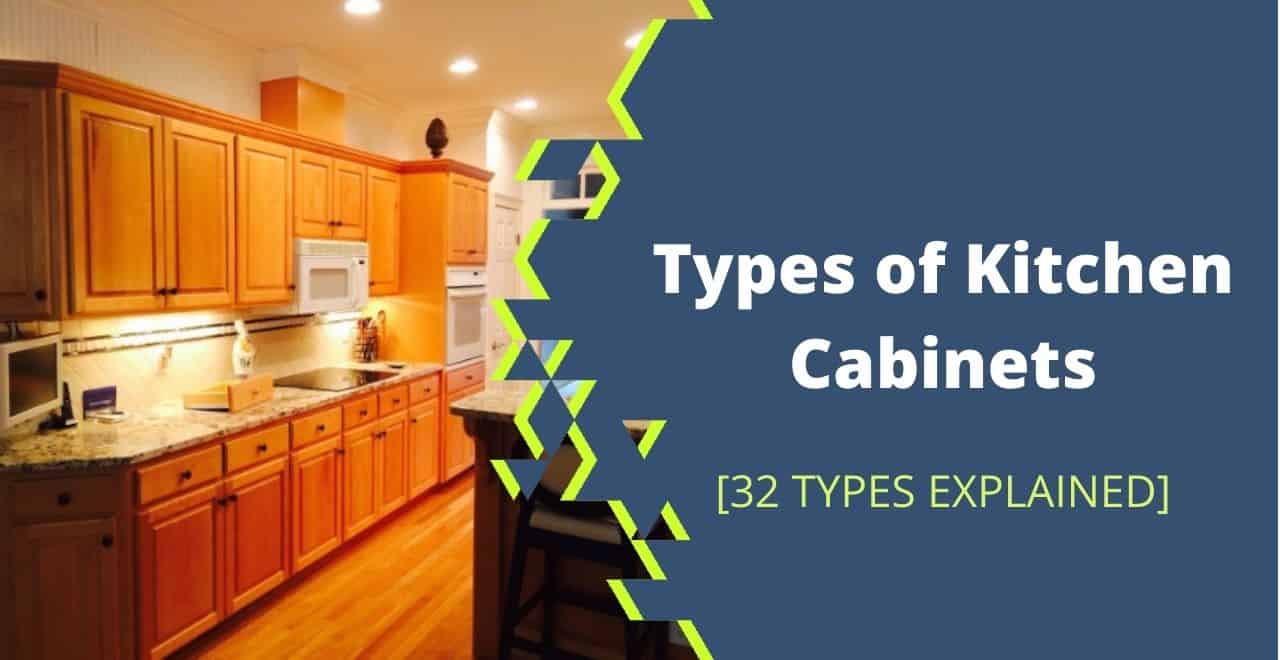Do you know that your kitchen cabinet is a high-traffic area in the kitchen?
Your cabinet is prone to spills, dust, grime, and grease. Irrespective of how careful you are as a homeowner, regular cleaning will always be needed.
Consequently, your kitchen cabinet is a focal point when it comes to cleaning the entire kitchen. It requires proper cleaning and maintenance to keep it glowing.
It also calls for keenness to ensure you don’t mess with its finish.
But how do you regularly clean without removing the finish? Read on as I explain this to you step by step.
JUMP TO: CABINET FINISHES TYPES | CLEANING METHODS | CLEANING AGENTS TO AVOID |
Types of Kitchen Cabinet Finishes

Kitchen cabinet finishes are of different types. They include:
- Glazed
- Acrylic kitchen cabinets
- Lacquer
- Veneer
- Laminates
- Natural
- Painted
- waterborne
- stained
- varnished
- Distressed
- Ultraviolet
- Membrane
How to Clean Kitchen Cabinets Without Damaging the Finish
Cleaning your kitchen cabinets with scrub brushes and abrasive cleaners is bound to damage the finish. However, you have other options that are appropriate and finish-friendly. They include:
Dawn Dish Soap
Consider dawn dish soap if you are looking for a cleaning agent that won’t remove your cabinet finish.
Dawn dish soap is mild enough and safe for your kitchen countertop finish. Moreover, it’s an excellent degreaser that removes up to 99% of tough grease.
Irrespective of your cabinet’s type of finish, dawn dish soap is safe and effective.
How do you clean cabinets with dawn dish soap?
Firstly, put a few drops of dawn dish soap into a bowl of warm water and mix the formula properly.
Dip a sponge into the mixture and wring out excess water.
Wipe your kitchen cabinet with a wet sponge. If possible, follow the grain in a back and forth movement.

If you encounter any stubborn stain, apply a drop of dawn soap directly, then scrub gently.
Using another clean sponge, rinse the surface of the kitchen countertop.
Dry the surface with a clean paper towel.
Also Read: Is Dawn Dish Soap Safe to Use on Granite Countertops?
Murphy’s Oil Soap
Murphy’s oil soap is another cleaning detergent that is entirely safe for your laminate and painted cabinets. It’s ideal if you are looking for a cleaning detergent that digs into grime and loosens it.
It’s made of 98% naturally-derived vegetable oils. Moreover, you can use it to refresh your wood cabinet if it looks old and tired.
How do you clean kitchen cabinets with Murphy’s soap?
For an entire cabinet, mix ¼ or ½ cup of Murphy’s oil soap into a bucket of hot water.
Tip: Warm or hot water makes your work easier, especially if you want to dislodge any stubborn dirt or grease.
Dip a rag or sponge into the formula, then squeeze the excess water
Using the sponge, wipe your kitchen cabinets, rinsing the sponge on a need basis.
Once you are done, dip another sponge in a bucket of pure warm water. Use it to rinse the cabinet surfaces before drying them with a dry rag.
Caution: Ensure you dry the cabinets properly because any moisture residue may affect your cabinet’s finish.
Orange Glo

Orange Glo rates as a high-quality cleaner, polish, and conditioner. It’s made of natural oils from orange peels and contains no water, wax, or alcohol.
Besides cleaning your kitchen cabinets, Orange Glo is an excellent degreaser and has high efficacy in removing accumulated dirt. You can also use it to revitalize your wood cabinet and give it a brilliant luster.
But there’s more,
Orange Glo fills the air in your kitchen and cabinet with the sweet smell of fresh oranges. With all these benefits, orange Glo is safe for your cabinet finish.
How do you use Orange Glo on kitchen cabinets?
Orange Glo is easy to use; spray it on a sponge, then use it to mop or wipe the cabinet surface in circular motions.
If your cabinet has heavy wax or grime, allow the detergent to rest for 10 minutes before wiping it.
In my research, I came across customer feedback indicating that Orange Glo also removes scratches from wooden surfaces. It also creates a moisture barrier on your surface, which is undoubtedly a huge plus.
Rejuvenate
Can I use Rejuvenate on my wood cabinets?
Yes, rejuvenate is a pH-balanced kitchen cabinet cleaning solution that leaves no residue behind. It’s a lemon-scented cleaner that is safe for all cabinet finishes.
You can use it to:
- remove stubborn grease and grime
- remove fingerprints
- clean dirt
- clean any daily smudges on the kitchen cabinet
How do you use rejuvenate on kitchen cabinets?
You simply spray it directly on the cabinet surface, then wipe it using a sponge or a microfiber cloth. It leaves the surface rejuvenated, plus a pleasant lemon scent.
Customer reviews show that this product is gentle and effective. It also gives your kitchen countertop a nice glow and leaves it restored to a brand new condition. It’s no wonder that many customers have given it a five-star rating.
Pine Sol
Pine-Sol is a deodorant and a degreaser. Moreover, it’s ideal for removing dirt from your kitchen cabinets.
If you use it according to the manufacturer’s instructions, it can also kill 99.9% of germs. Consequently, it’s also considered a disinfectant.
Important Note: Pine-Sol may leave a residue on the cabinet surface if you don’t dry it properly.
Pine-Sol comes in four different variations:
- original pine-sol
- lemon fresh
- lavender clean
- sparkling wave
- How do you use it?
Put ¼ cup of the detergent in a bucket of warm water to dilute it.
Dip a sponge inside the formula and wring it to eliminate excess water.
Using the sponge, wipe every part of your kitchen cabinet, including the drawer pulls. Remember to rinse the sponge frequently.
You may require using some additional force on areas with stubborn grease or dirt.
Get another sponge, dip it in pure warm water and rinse the cabinet surface.
Finally, use another dry clean cloth and wipe the kitchen cabinet dry.
Caution: Pine-Sol may cause health issues if ingested; use it carefully according to the instructions.
Olive Oil
Are you looking for a safe and effective cleaning product that can condition your wood kitchen cabinets?
Olive oil has excellent conditioning properties and is great for your cabinets. It soaks in wood, swells the wood fibers then deepens their color. It is safe and effective.
Moreover, it helps fix scratches and clean wood cabinets. Pour olive oil on a scratch and allow it 24 hours before wiping it. Repeat this process until the scratch disappears.
How do you clean kitchen cabinets using olive oil?
Mix one part of lemon juice or vinegar with two parts of olive oil using warm water.
Put the formula in a spray bottle.
Spray the mixture directly on your cabinet surface, then wipe using a sponge or clean cloth.
Important Note: Before each spray, shake the spray bottle well to ensure the oil is properly mixed.
Use soft brushes or clothes.
You can clean your kitchen cabinet with soft cloth or brushes without affecting the finish. Mostly, you will use these to target the corners, door handles, and hard-to-reach areas.
However, you can only use soft brushes together with other cleaning products.

If your kitchen cabinet has sticky grease, apply one part of baking soda with two parts of water, make a paste, apply, and then allow it to sit for a few minutes.
After that, use a toothbrush to scrub the surface or wipe it out using a damp cloth gently to get rid of the stubborn grease.
Caution: Ensure that your brush is soft; hard brushes will scrub the surface and affect the finish.
Dish Soap and Warm Water
I have discussed several cleaning products so far. However, do you know that one of the best cleaning products is always there with you in the kitchen?
Simple soap and warm water solution will do excellent work on your kitchen cabinets. Whether you plan on doing a quick wipe-down or comprehensive deep cleaning, this solution will suffice.
Liquid dishwashing detergent and warm water can clean food messes, grease, dust, and even splatters.
One more amazing thing,
Dish soap and warm water solutions are ideal for most kitchen cabinet types. Whether metal, wood, painted, vinyl, laminate, and many more, this solution will do great work.
How do you do it?
- Add a few drops of dish soap to a bowl of warm water
- Mix it using your hand
- Take a sponge or microfiber cloth and wipe your kitchen cabinet down, including all the drawer pulls.
- Rinse with warm, clean water and another sponge, then wipe dry.
Cleaning Agents to Avoid
I’m sure you have desired to see your cabinet glow for many years. You can only achieve these if you avoid using some cleaning products.
I have listed for you here some products that will adversely affect your kitchen cabinet finish. Keeping them away from your cabinets will secure the finish.
Avoid using:
- lemon oil
- magic eraser
- coarse or abrasive cloths or pads
- soap pads, scouring pads, and brushes
- ammonia or products that contain ammonia
- strong solvent cleaners and other harsh cleaning chemicals
- sprays intended for furniture
- Bleach and chlorine-based cleaners
Most of these products contain chemicals harmful to your cabinet’s finish. Others have acidic properties that will corrode the finish.
Some like pads will scratch the kitchen cabinet finish and cause it to begin wearing off. Lastly, bleach and chlorine-based cleaners will stain surfaces.
How to Know the Right Cleaner that will not Remove Finish
Choosing the right cleaner for your kitchen cabinet may not be easy. However, to protect the finish, you must be prudent on what cleaner to use.
Below are a few guidelines to help you choose the right cleaner.
- Read the reviews of the product before you buy it. You will know whether it’s suitable for your use or otherwise.
- If you are unsure what cleaner to use, contact the cabinet manufacturer. They will help you know what cleaner will work best for your cabinet’s finish.
- Test every cleaner before using it. Apply a small amount of it to a discreet area and see if it affects the finish.
![How To Clean Grease Off Laminate Kitchen Cabinets? [Full Guide] How To Clean Grease Off Laminate Kitchen Cabinets? [Full Guide]](https://houseadorable.com/wp-content/uploads/2022/06/cleaning-cabinets-cover.jpg)

![How Long Does it Take to Install Kitchen Cabinets? [Steps Explained] How Long Does it Take to Install Kitchen Cabinets? [Steps Explained]](https://houseadorable.com/wp-content/uploads/2022/07/kitchen-cabinet-installation.jpg)

![36 Vs. 42 Kitchen Cabinets [7 Differences Explained] 36 Vs. 42 Kitchen Cabinets [7 Differences Explained]](https://houseadorable.com/wp-content/uploads/2022/10/cab.jpg)
![How to Make Kitchen Cabinets Look Glossy? [A Complete Guide] How to Make Kitchen Cabinets Look Glossy? [A Complete Guide]](https://houseadorable.com/wp-content/uploads/2022/07/glossy-cabinet-1.jpg)
![How to Repair Kitchen Cabinets with Water Damage? [Steps Explained] How to Repair Kitchen Cabinets with Water Damage? [Steps Explained]](https://houseadorable.com/wp-content/uploads/2022/07/50022-IMG_3860.jpg)
![Gloss Vs. Matte Kitchen Cabinets [7 Key Differences Explained] Gloss Vs. Matte Kitchen Cabinets [7 Key Differences Explained]](https://houseadorable.com/wp-content/uploads/2022/12/white-high-gloss.jpg)